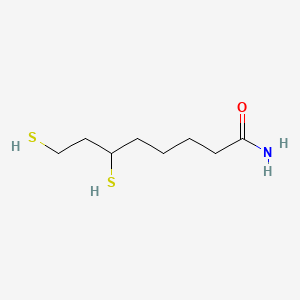| MeSH term | MeSH ID | Detail |
|---|---|---|
| Parkinsonian Disorders | D020734 | 20 associated lipids |
Dihydrolipoamide
Dihydrolipoamide is a lipid of Fatty Acyls (FA) class. Dihydrolipoamide is associated with abnormalities such as Wiskott-Aldrich Syndrome. The involved functions are known as Citric Acid Cycle, Electron Transport, NADH oxidation, Oxidation and Oxidants. Dihydrolipoamide often locates in Mitochondria, Mitochondrial matrix and Chloroplasts. The associated genes with Dihydrolipoamide are Mutant Proteins, Recombinant Proteins, mycothione reductase, Genes, Mitochondrial and alanylproline.
Cross Reference
Introduction
To understand associated biological information of Dihydrolipoamide, we collected biological information of abnormalities, associated pathways, cellular/molecular locations, biological functions, related genes/proteins, lipids and common seen animal/experimental models with organized paragraphs from literatures.
What diseases are associated with Dihydrolipoamide?
Dihydrolipoamide is suspected in and other diseases in descending order of the highest number of associated sentences.
Related references are mostly published in these journals:
| Disease | Cross reference | Weighted score | Related literature |
|---|
Possible diseases from mapped MeSH terms on references
We collected disease MeSH terms mapped to the references associated with Dihydrolipoamide
PubChem Associated disorders and diseases
What pathways are associated with Dihydrolipoamide
There are no associated biomedical information in the current reference collection.
PubChem Biomolecular Interactions and Pathways
Link to PubChem Biomolecular Interactions and PathwaysWhat cellular locations are associated with Dihydrolipoamide?
Visualization in cellular structure
Associated locations are in red color. Not associated locations are in black.
Related references are published most in these journals:
| Location | Cross reference | Weighted score | Related literatures |
|---|
What functions are associated with Dihydrolipoamide?
Related references are published most in these journals:
| Function | Cross reference | Weighted score | Related literatures |
|---|
What lipids are associated with Dihydrolipoamide?
There are no associated biomedical information in the current reference collection.
What genes are associated with Dihydrolipoamide?
Related references are published most in these journals:
| Gene | Cross reference | Weighted score | Related literatures |
|---|
What common seen animal models are associated with Dihydrolipoamide?
There are no associated biomedical information in the current reference collection.
NCBI Entrez Crosslinks
All references with Dihydrolipoamide
Download all related citations| Authors | Title | Published | Journal | PubMed Link |
|---|---|---|---|---|
| Stöckel J et al. | Diurnal rhythms result in significant changes in the cellular protein complement in the cyanobacterium Cyanothece 51142. | 2011 | PLoS ONE | pmid:21364985 |
| Garbeva P et al. | No apparent costs for facultative antibiotic production by the soil bacterium Pseudomonas fluorescens Pf0-1. | 2011 | PLoS ONE | pmid:22110622 |
| Schmidt MC et al. | Efficient α, β-motif finder for identification of phenotype-related functional modules. | 2011 | BMC Bioinformatics | pmid:22078292 |
| Brautigam CA et al. | Structural and thermodynamic basis for weak interactions between dihydrolipoamide dehydrogenase and subunit-binding domain of the branched-chain alpha-ketoacid dehydrogenase complex. | 2011 | J. Biol. Chem. | pmid:21543315 |
| Suetsugu-Maki R et al. | A complement receptor C5a antagonist regulates epithelial to mesenchymal transition and crystallin expression after lens cataract surgery in mice. | 2011 | Mol. Vis. | pmid:21541266 |
| Cruz-GarcÃa C et al. | Fnr (EtrA) acts as a fine-tuning regulator of anaerobic metabolism in Shewanella oneidensis MR-1. | 2011 | BMC Microbiol. | pmid:21450087 |
| Crăiţoiu MM et al. | Clinical and histoenzymatic interrelations of the edentulous ridge's mucosa. | 2011 | Rom J Morphol Embryol | pmid:21424039 |
| Hakansson AP et al. | Apoptosis-like death in bacteria induced by HAMLET, a human milk lipid-protein complex. | 2011 | PLoS ONE | pmid:21423701 |
| Aranjuelo I et al. | Plant physiology and proteomics reveals the leaf response to drought in alfalfa (Medicago sativa L.). | 2011 | J. Exp. Bot. | pmid:20797998 |
| Feeney MA et al. | Repurposing lipoic acid changes electron flow in two important metabolic pathways of Escherichia coli. | 2011 | Proc. Natl. Acad. Sci. U.S.A. | pmid:21521794 |
| Kumar A et al. | Redox homeostasis in mycobacteria: the key to tuberculosis control? | 2011 | Expert Rev Mol Med | pmid:22172201 |
| Vazquez A et al. | Serine biosynthesis with one carbon catabolism and the glycine cleavage system represents a novel pathway for ATP generation. | 2011 | PLoS ONE | pmid:22073143 |
| Natarajan P and Parani M | De novo assembly and transcriptome analysis of five major tissues of Jatropha curcas L. using GS FLX titanium platform of 454 pyrosequencing. | 2011 | BMC Genomics | pmid:21492485 |
| Stobbe MD et al. | Critical assessment of human metabolic pathway databases: a stepping stone for future integration. | 2011 | BMC Syst Biol | pmid:21999653 |
| de Graaf RM et al. | The organellar genome and metabolic potential of the hydrogen-producing mitochondrion of Nyctotherus ovalis. | 2011 | Mol. Biol. Evol. | pmid:21378103 |
| Liang L et al. | Large scale immune profiling of infected humans and goats reveals differential recognition of Brucella melitensis antigens. | 2010 | PLoS Negl Trop Dis | pmid:20454614 |
| Kim SY and Kim J | Roles of dihydrolipoamide dehydrogenase Lpd1 in Candida albicans filamentation. | 2010 | Fungal Genet. Biol. | pmid:20601046 |
| Viadas C et al. | Transcriptome analysis of the Brucella abortus BvrR/BvrS two-component regulatory system. | 2010 | PLoS ONE | pmid:20422049 |
| Chen W et al. | Disruption of ptLPD1 or ptLPD2, genes that encode isoforms of the plastidial lipoamide dehydrogenase, confers arsenate hypersensitivity in Arabidopsis. | 2010 | Plant Physiol. | pmid:20488895 |
| Pei Y et al. | Plasmodium pyruvate dehydrogenase activity is only essential for the parasite's progression from liver infection to blood infection. | 2010 | Mol. Microbiol. | pmid:20487290 |
